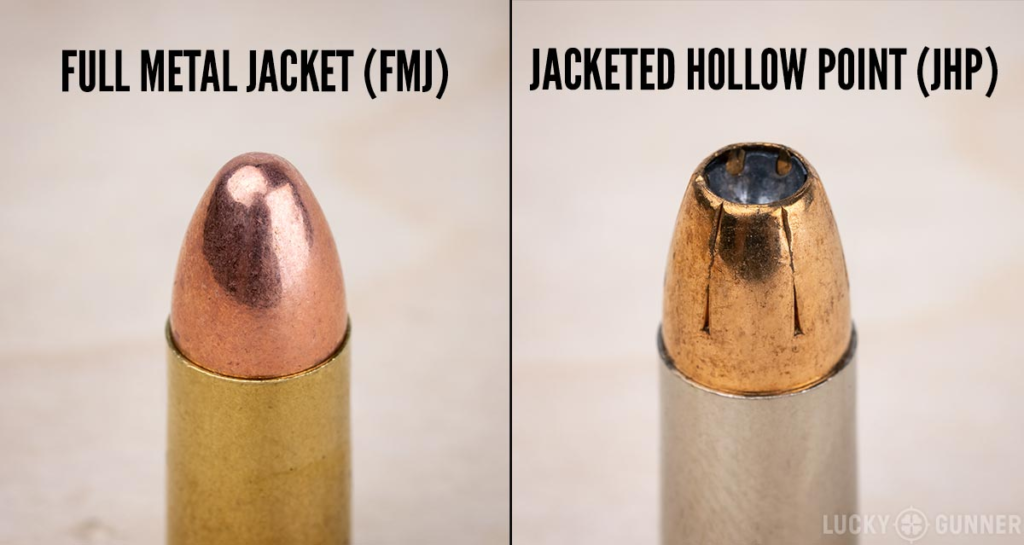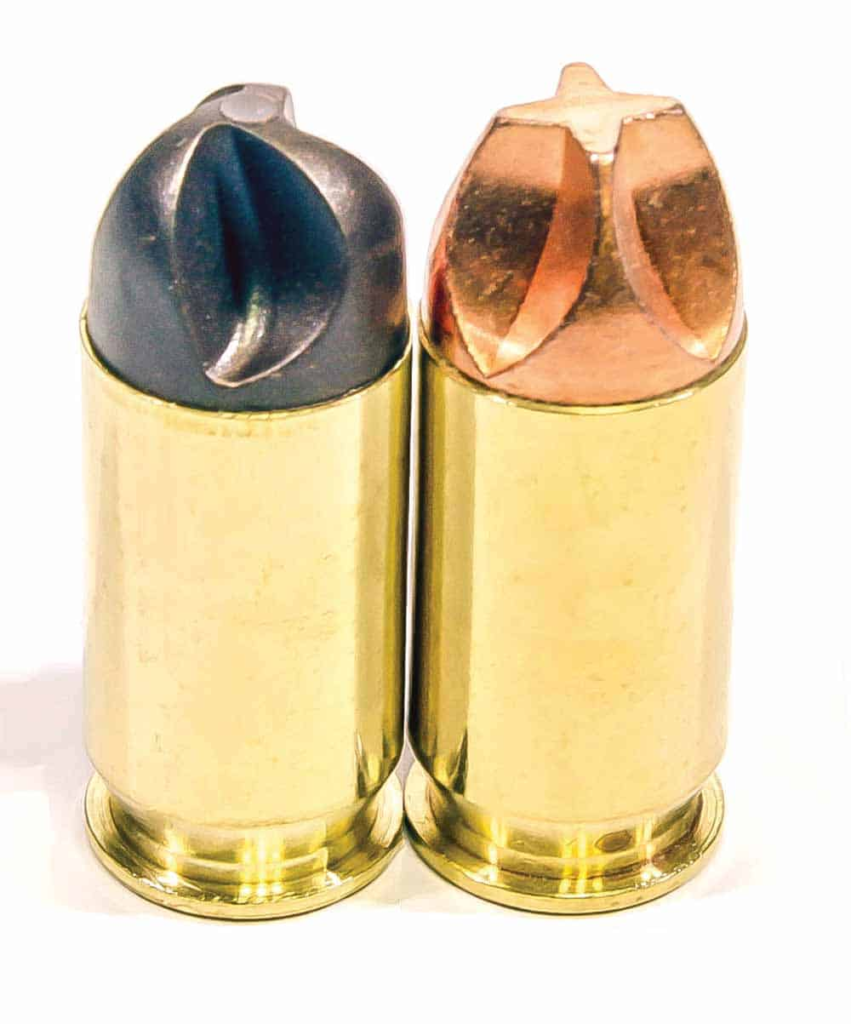In the on-going series about my experiences teaching firearms stuff, we’re going to take a look at ammo choices. I’m not talking about calibers, that’s a different discussion for a different day. What we’re going to look at are different types of projectiles for a variety of use cases.
There are a wide variety of bullets available to the shooter today that will fit whatever role you want them for. Let’s take a look at the different types of projectiles available for most shooters.
We can break down the types into several general categories, full metal jacket, jacketed and semi-jacketed hollow points, cast lead and mono-metal, non-lead projectiles. The last are typically hollow points, but not always.



Non-lead bullets are required for hunting on many western federally owned lands and in some states, namely Commiefornia. My home state, NY, is requiring non-lead projectiles for big game, deer and bear, on state owned lands starting next hunting season.
I bring up this topic because a recent student told me he only used FMJ bullets in his carry piece, a little pocket .380. That sparked a class discussion of bullet choice and use cases for the variety of bullets that are available.
While I consider .380 as being less than optimal for carry, but as I said above that’s a discussion for another day, when loaded with the proper bullet, it can be an effective self defense round. Are FMJs that choice? No. Are FMJs a good choice for carry in any other caliber? Again, the answer is likely no (there may be a few exceptions, but those exceptions are rare and caliber specific).
But KITDAFBS, the military uses full metal jacket bullets, surely they’re good enough for self-defense you might say. (Yes, that was the rejoinder for the student.) Well, no. The military use of FMJ ammo dates back to the 1st Geneva convention, which banned any other type of projectile in warfare.
That begs the question, what bullet is best for my intended task? Well, like most things, the task defines the tools. You wouldn’t try to tighten a bolt with a hammer now would you? So, what’s the best task for each bullet type? We’ll take a look at the construction and best use case for each type.
Full Metal Jacket Projectiles
If you served in the military, this is the type of projectile you fired. The US military uses FMJ almost exclusively in small arms ammo. There are some very specific exceptions; some of the MP/SP/USAF SF use hollow points in their duty pistols and there are .50 BMG loads other than FMJ. Even tracers are FMJ constructed bullets, they just have a hollow base to contain the tracer compound.

The construction of these projectiles is fairly simple. A copper alloy jacket surrounds a core, usually lead. FMJ bullets are relatively inexpensive to manufacture because of the simple construction. That makes the ammunition considerably less expensive than hollow points of the same caliber. There is a variation of the FMJ called the TMJ, or Total Metal Jacket. The core is completely surrounded by the jacket in that type.
So, when and where is the FMJ best used? The answer to that is pretty simple: at the range.
The lack of terminal expansion is one of the major reasons for that. A 5.56 FMJ makes a .224″ diameter hole going in and out. They do not expand on impact, and the permanent wound channel is bullet diameter plus a tiny fraction.
Cost is another factor. A box of 50 9mm FMJ around here costs about $15 give or take, meanwhile a box of 25 9mm hollow points starts at about $20 and goes up from there depending on the name on the box.
There is an exception (when isn’t there an exception?) to not using FMJ bullets for anything but the range, and that is furbearer hunting. An FMJ leaves two little neat holes in the hide, while a traditional hunting bullet will leave one small hole and one really big one.
Expanding Handgun Projectiles
There are a wide variety of expanding handgun bullets available. These fall into one of three major categories; jacketed hollow points, soft points and semi-jacketed soft points. Of the three, you are most likely to find JHP rounds at your local ammo supplier. Soft points and semi-jacketed rounds are older types and usually only found in revolver calibers.

All three types expand on impact, creating a larger-than-caliber permanent wound channel. They also transfer more energy into the target and create a much larger temporary wound channel. The energy dump and larger wound channels equate to ‘stopping power’.
Your editor carries a Glock 43x with 124 gr Gold Dots from Speer, but there are a lot of other good choices. The Speer rounds work well in my gun and point of impact/aim are the same as the 124 gr FMJ I practice with.
I am not going to go into any of the specialized pistol target rounds like the wad-cutter here. Just know that they have their place, and that’s at the range. I am also going to avoid the ‘screwdriver’ type rounds. I’m talking about the ARX from Inceptor and the clones. I haven’t seen enough data about them to have formed an opinion, and frankly, the lack of data makes me wonder about the utility of that particular projectile. YMMV. . .

There is another relatively common kind of pistol ammo available: Hard cast lead. For the most part, hard cast bullets are used in hunting scenarios where deep, and I mean deep, penetration is desirable. That kind of ammo is generally used for game like bears and elk, critters with large, heavy bone structures that would break a jacketed bullet apart on impact. The hard cast lead rounds tend to expand little and drive through heavy bone without much trouble. Hard cast lead can also be found in rifle calibers, and the use case is much the same: deep penetration through heavy bone.
Expanding Rifle Projectiles
There are a wide variety of expanding rifle bullets out there. We can break them out into one of three basic construction categories: cup-and-core, partition and mono-metal solids. The cup-and-core bullets are the simplest and most common rifle bullets. As the name suggests, they are a cup of copper alloy filled with a core of lead.

They come in several tip styles, soft point, like above, hollow point or ‘protected point’ also known as Ballistic tip. They may also have some sort of ‘locking’ mechanism that either bonds the core to the cup or mechanically attaches the two. This is done to help prevent jacket separation, which is when the core and cup separate under impact. That can reduce penetration and increase the chance of a mere wound instead of a fatal shot.
The cup-and-core bullet is a good choice for game like deer, caribou and pronghorn in the appropriate calibers. Those animals are not particularly tough animals and don’t take a lot to harvest them cleanly.
I’m going to take a second here to discuss a sub-type of cup-and-core projectiles: Frangibles. Designed to break up on contact with a hard surface, frangible bullets are used for predator/furbearer hunting. There are a couple of brands out there that market frangible rifle ammo for home defense. The idea is that you can use your rifle without worrying about accidentally shooting a neighbor. If you use a rifle for that purpose, I think the frangible rounds are a decent idea, especially if you live in a densely populated area.

Partition bullets are constructed differently. They have an ‘H’ shaped copper alloy jacket with spaces above and below the partition for core material. Again, they come in several tip styles, either soft point(pictured above), hollow point or protected point.
Typically used for heavier game animals like bear, moose and elk, this style of projectile holds together better when they hit heavy bone.
Mono-metal solids are just that, a solid chunk of metal in the shape of a bullet. Barnes, the best known maker of this kind of projectile, uses a copper alloy, but some other manufacturers use bronze. This type of projectile only comes in two flavors; hollow point or protected point.

Because of the changes in laws around the country, I think you will be seeing more and more mono-metal solids in hunting calibers at your local supplier. I will admit my first experiences with copper solids left me feeling a bit underwhelmed, the terminal performance of this type of projectile has come a long way. I have personally harvested several deer and a black bear with copper solids, and they performed well.
I’m sure I’ve missed some of the specialized bullets, there are a lot of manufacturers and bullet types out there. If I missed your favorite, I’m sorry, I don’t know everything and be sure to drop it in the comments.
